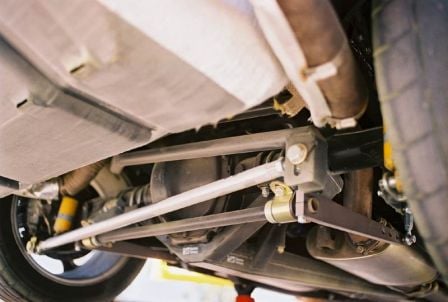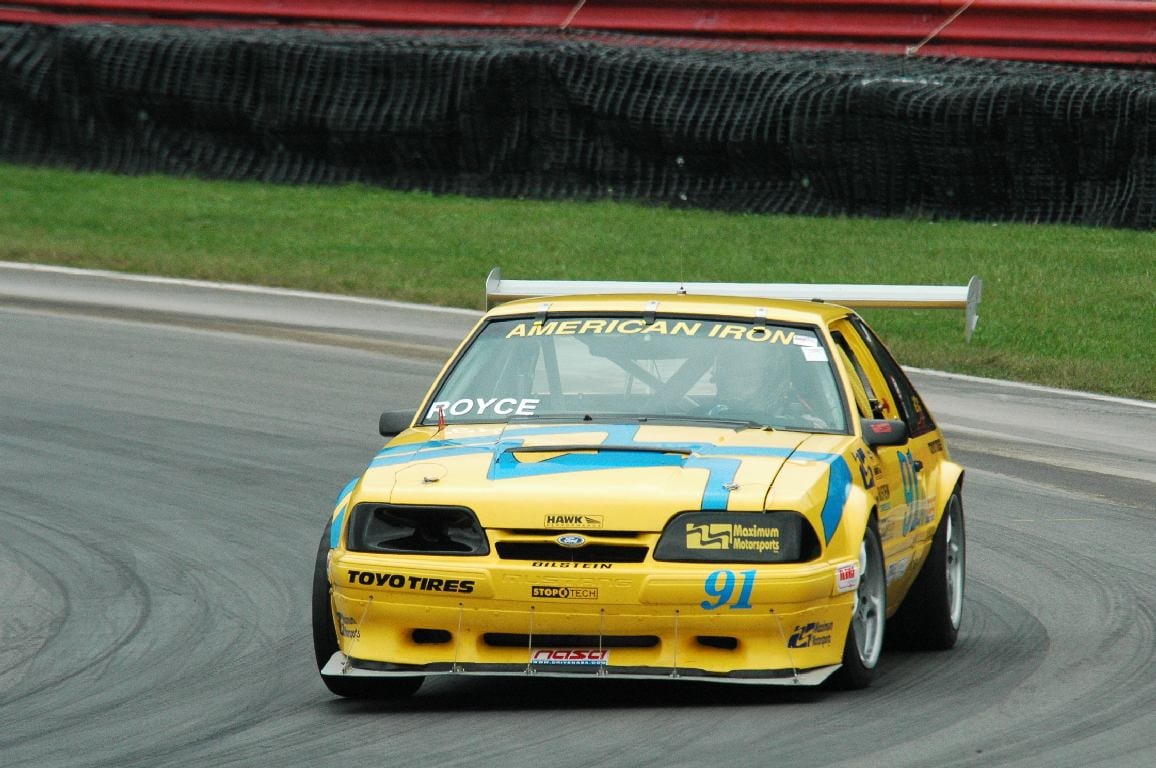When Ford decided to design its ’99 Cobra with an independent rear suspension (IRS), road racers rejoiced. It promised track rats a better relationship with the rear of their Mustang; getting it to communicate clearly and lose grip in a manageable, progressive manner. It also promised a softer, less jarring ride with minimal reduction in NVH. These two perks made the prospect of a Mustang capable of leaving corners on par with a Porsche 911 a reality for some.
These aren’t the only reasons to swap a Cobra’s IRS into an SN95 or Fox-body chassis. For one, the independent rear suspension has a tapered wheel bearing in each hub, which keeps the brake rotor aligned with the brake caliper for minimum brake pad kickback under high cornering loads. It also does away with the issue of bending axle shafts: a common problem with a high-horsepower, high-grip car sporting a solid rear axle. This is due to the fact that the design offers slightly less support at the ends of the axles.

An additional 122 pounds of unsprung weight and no camber adjustments make a solid axle a less desirable choice among most road racers.
There aren’t too many shortcomings when it comes to IRS for road racing applications. The need to align both ends and sort out the IRS’ bumpsteer, a tendency to wheelhop, and cost are the only issues with IRS. Because of the availability of this independent rear suspension and one company’s racing experience with it, swapping one in is a promising proposition in some enthusiast’s eyes.
Improving a Comprehensive Swap Package
Fortunately, some of the conversion cost was minimized through Maximum Motorsports‘ efforts in American Iron. Having built a few race-winning independent rear-equipped Mustangs made it possible to design a cost-effective swap package with the ancillary parts and geometry changes needed to optimize this particular design.
Since the package hit the market nearly twenty years ago, they’ve made a few steps to better the design. They realized how important it was to have the spring located more towards the centerline of the A-arm, or more within the ‘A.’ This change helps minimize some of the friction in the pivots caused by Ford’s factory mounting location of the spring and the resulting bending and twisting in the control arm.
The coilover design also moves that spring closer to the wheel, which makes it possible to run a softer spring while still providing the same wheel rate. The result is a lighter, smaller spring with less friction in the pivots because the further inboard a spring is, the more force the inboard pivots are seeing.
Testing That Theory At Buttonwillow
The team spent their first day at Buttonwillow dialing the car in and finding a setup that would yield quick, consistent times. The second day, they asked their driver Mike Croutcher to find the limit and set a lap indicative of that setup’s potential.
Then the real work began.
That evening, the crew brewed up another couple of pots of rocket fuel and started installing the independent rear suspension. To try and control for the changes between the rear ends, the team retained the same tires, wheels, brakes, and amount of roll stiffness at both ends.
Over undulations and rougher surfaces, it was obvious that the independent rear suspension held the advantage. The most abrupt changes in direction favored the new setup, too. These two qualities made the IRS-equipped car much stronger through the esses than its forebear. It gladly hopped curbs and settled so well that it was hard to fathom. While this hopping would’ve spat the solid-axle arrangement off the intended line by half a car width, the new car could straight-line most of these technical sections and put the power down without a fuss. “We could clobber the curbs all we wanted and nothing went wrong. We were trying to break the car, but we couldn’t,” Mike laughed.

The Bus Stop, Phil Hill, and the esses before Sunset—these were all areas where the independent rear-equipped car really shined.
For this reason, he could carry a full head of steam along the fastest and straightest part of the track. All these improvements amounted to a lap time three seconds faster than what Croutcher could manage with the old setup.
It wasn’t without its setbacks, however. Interestingly, in certain sections where power application was paramount, the solid axle had an undeniable edge. With the old-fashioned axle sending power to the Toyo RA1s underneath him, Mike found he dealt with less wheelspin when applying the throttle—over flat sections of road, anyways.
Street Translation
The area that Mike finds people appreciating IRS most are on rougher surfaces (ie. most public roads). On crowned, cratered, and uneven canyon roads, the added reassurance, and stability gave their test driver supreme confidence.
“The car won’t suddenly slither into the other lane, onto an embankment, or off a cliff. Also, you can run soft springs to absorb all the bumps and increase the roll stiffness through swaybars. For those reasons, you’ve got a much better road car on your hands,” Mike declared.
“You can roll more entry speed because you’re not concerned with the rear unsettling over the bumps. This is less of an issue on the track, but on the street, you need to be a little more cautious and that sort of nervousness doesn’t help me feel too sure of the car. Actually, if the suspension is settled and the power isn’t too much, the Mustang becomes a momentum car. I know it’s hard to believe, but this Mustang feels like a big Miata.”
Swapping An Entire Suspension
Quite unlike the tightly-packaged Miata, the Mustang’s greater size makes tinkering on it a little easier. In fact, the swap itself is fairly straightforward and most folks with moderate mechanical ability shouldn’t find the task too challenging. Although the track width is slightly wider among the “New Edge” cars, the provisions are almost entirely there for the prior years of that generation. Even the Foxbody will accommodate the new independent rear suspension. All that one needs is a drill for the holes used to mount some of the new brackets, a new exhaust, the brake line modifications, and the correct bolts. Thankfully, Maximum Motorsports offers most of these items on their website.
The solid axle’s lower control arm is where the independent rear suspension mounts to. The point where the control arm mounts to the body uses a 12mm bolt in the 1994-98 cars, but the 1999-04 cars use a 14mm bolt there. Once you’ve determined the right bolt to use, you must either drill a hole in the rear of the frame or add an extension bracket, source a crush sleeve, and bolt everything in place. The only ancillary items which need to be changed afterward are the exhaust, the brake lines, and the brake cables—most of which are available at Maximum Motorsports.
Alexandros Varvounis took that same route, albeit with a Foxbody. After seeing how Kenny Brown’s IRS-equipped Mustang had decimated the local competition, he had to retrofit his Foxbody. As he learned, there are other points to remember if the Foxbody is the chosen chassis. “While the suspension bolts into the bottom of the SN95’s frame rail, the Foxbody needs a nut plate. Plus, the independent rear suspension’s subframe requires putting two bolts into the bottom of the frame rail and nut plate,” he mentioned.

The pinion flange on the front of the differential will need to be changed to bolt up to the Foxbody’s driveshaft.
His final touch, suggested to him by Kenny Brown, is a plate on the bottom of the bolts as well as a secondary plate on the side of each frame rail. “You need this to minimize shearing under compression. Otherwise, you’re just leaning on the horizontal bolts which are not sturdy enough,” he warned.
The Final Touches
To go the extra step, Varvounis opted for a few additions shown to work from Kenny Brown. Brown had noticed significant toe-out under compression after first adding the new suspension to his track car and took his suspension off the car and back to the workbench.
The following changes made the toe change negligible. By raising the four pickup points by a half-inch, they position the bolts not perpendicular to the ground, but at a slightly upwards angle. Along with a solid mounting point and steel Heim joints, the flex and shifting in the rear is more or less minimized.
“When you make these changes, the only limiting factors become the wheel and the tire,” Varvounis noted.
Hidley has a few points to make, too. “I would not install an IRS into another car without changing most of the stock bushings. Stiffer bushings will make the suspension much more predictable,” he notes. Also, this fixes an issue specific to the independent rear: wheelhop. With the addition of stiffer bushings, most of the deflection will be minimized to a point where the negative effects are negligible. However, this will not hold true if the level of power present can overwhelm the rears easily; this fix only applies to cars with power levels slightly above factory.

Getting the IRS subframe mounted properly with the right bracket and the right bushings makes a massive difference.
However, there is one bushing that shouldn’t be made too stiff. “The one exception to this is the IRS subframe bushings. As long as these have a reasonable amount of compliance, the NVH level will be low and acceptable. Polyurethane works very well in this application. As soon as the IRS subframe bushings become less compliant, road noise, gear whine, and other noises get conducted directly into the chassis, where they can be heard and felt,” Hidley advised.
With all these changes in place, the Mustang becomes a car that won’t rattle one’s fillings out, but it still corners with the certainty and compliance of a well-rounded track car. Without a doubt, the IRS is a step forward, even if the solid axle has its merits and can be tuned to work quite well.
As this exploration has shown, the right way towards maximizing a motorsports-oriented Mustang’s potential is to modernize the rear, remove what slack is there, and make sure the tire and wheel suit the setup. With that, a Mustang can exit corners with the same certainty felt by most 911 owners. Wouldn’t that be nice?



















